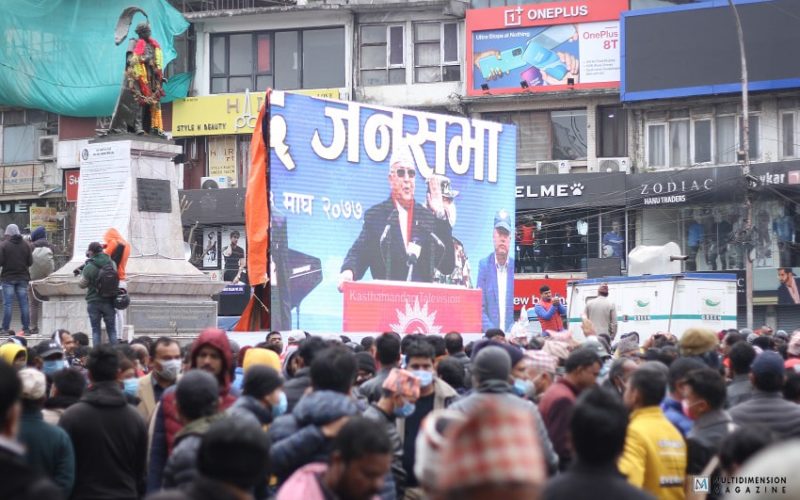Written by : Dr. Anup Shekhar Chakraborty.
Photo credit : Shutterstock.com
Comrades in Alliance: House of Cards
The Left-wing politics in Nepal has obliterated Rajshahi (Monarchy) and associated caste-class social hierarchies, yet Samajwad (Socialism) remained a statist utopia. Nepal’s uniqueness is that it tends to present trends in deviation from global experience. While globally communists and communist ideology are in life-support, and communist parties have dwindled, let alone be in determining political positions, Nepal post-2018 presents a case in contradistinction. In 2018 the electoral alliance of the two main communist parties in Nepal won a nearly two-thirds majority in Parliament. The coalition led to a merger of the CPN-UML (Communist Party of Nepal-United Marxist Leninist) and CPN-MC (Communist Party of Nepal-Maoist Center) and the evolution of the Nepal Communist Party (NCP). The formidable electoral support rode on anti-India nationalist rhetoric. K.P. Sharma Oli (CPN-UML Chairman) took over the reins of control. This was perhaps the strongest democratically elected government that Nepal had experienced and painted a Samajwad in broad-strokes from Prachandapath (Prachanda’s way) to Olipath (Oli’s way). The paper continues to glean the muddled relations in the neighbourhood and wayfind a possible direction silhouetted on these complex intertwined issues.
The period following the 2015 earthquake and India’s response deficit to its Himalayan neighbour in crisis propelled the collective angst towards India and the Modi government. The economic embargo that followed through the ‘Chakka bandh/ Nakabandhi 2015’ in the India-Nepal border made life even more difficult for people in Nepal.’ Nepal at this stage also accused India of intervening in the making and adoption of ‘the new Constitution of Nepal.’ Nepal’s media (print and televised) reported, ‘India was inclined to the Madeshis.’ The media mediated communication wedged public opinion. Prime Minister Oli effectively leveraged this sentiment to win the national election for his leftist party. The trust deficit in the neighbourhood exacerbated by domestic politics and external constraints scripted the story of Comrades in alliance in Nepal.
The alliance of the comrades witnessed a series of factional quarrels. Pushpa Kamal Dahal and CPN-UML leader Madhav Kumar Nepal joined hands to oust Oli from power. Oli was asked to give up either the party chairmanship or the premiership. Nevertheless, Oli refused, thus deepening the rift in the new party. The Nepal Communist party has not been able to endear itself to the Janata despite the spectacular mandates in the 2017 elections. Questions that loomed primarily included: Was there a need for a left coalition in Nepal at all? Or was it the outcome of a pragmatic friendship? The leadership feuds between Oli and Dahal reflected the fragility of trust. This led to reconfigurations within the alliance and the rearrangements in the House of Cards to keep the bubble of friendship among the comrades alive.
Manufacturing Olipath
Nepal’s relations with India deteriorated steadily through 2019 to 2020. The ‘Kalapani-Lipulekh-Limpiyadhura’ cartographic contestations marked a low point in the Indo-Nepal ties. Oli’s government weaved a nationalist narrative of transgressions by the Indian side and checked the Hindu pilgrim passage to the holy Mansarovar in Tibet. The construction of a new road connecting Darchula and Kailash-Mansarovar via Lipulekh in May 2020 gaslighted the relations between the neighbours. The Kalapani-Lipulekh-Limpiyadhura issue, though old, gained prominence in November 2019 not only because of the release of maps by MEA-India after the creation of Union Territories of Jammu and Kashmir and Ladakh but also due to by-elections in Nepal. The main opposition party, the Nepali Congress, played up the issue to embarrass the Communist government in power in Nepal.
The endorsement of a new map depicting Kalapani-Lipulekh-Limpiyadhura as a part of Nepal by the Nepali Parliament and the gate-keeping (lit. Chowkidar, Pehredar) role that Oli styled for himself in the contested borderlands magnified Oli’s stature. As the gatekeeper holding the key to the Hindu pilgrim paths to Mansarovar, the Nepalese premier reinvented the centrality of Nepal even in matters ecclesiastical. All this to reaffirm the Janata that Nepal remains deeply Hindu though now constitutionally secular and ideologically communist. Furthermore, to send the message that Nepal has not lost its control as the epicentre of Hindu-Buddhist cosmology and a nation of unpolluted believers.
Oli, through a series of statements, manufactured his stature as a powerful equivalent to Modi. The stature manufacturing exercise of Oli can be contextualised to deeper issues of caste, class, religion, political ideology complex in South Asia. Oli took a jibe at India and mocked if India subscribed to the physical aspect of its emblem — the Lion Capital of Ashoka — “simhaev jayate” (lion alone prevails) or “satyamev jayate” (truth alone prevails). On 19th May 2020, Oli commented in the Nepal Parliament that the Indian virus was more lethal than the Chinese one and that Nepal should distance itself from the southern neighbour. After spinning Hindutva and Ramrajya, Oli claimed that Ram was born in Thori, Nepal and not in Ayodhya, India. Oli attempted to belittle the BJP’s achievements among the global Hindu through the verdict of the Supreme Court of India on the contentious Ramjanmabhoomi-Babri Masjid. Oli also churned the contested claims to the inherited, shared heritages of South Asia such as Yoga, the Vedic mantras, etc. In doing so, Oli reinstalled Nepal’s position as a Hindu Rashtra in a secular ecosystem. This occurred when a section believes that ‘India influenced the proposal to make Nepal a secular state.’ At the same time, the other segment felt that India wanted Nepal to be a Hindu nation. A section of the Janata construed this as Nepal reclaiming lost grounds and repositioning Nepal as a formidable Zone of Peace. While another felt it was Oli’s ego issues and his deep-seated desire to match his Indian counterpart, Narendra Modi, through Olipath.
Notion of Centrality
In Modi’s Neighbourhood First Policy, Kathmandu was central in improving economic and strategic integration in the subcontinent. Nepal’s new centrality was in multi-lateral arrangements like the Bay of Bengal Initiative for Multisectoral Technical and Economic Cooperation (BIMSTEC). Nepal, however, decided to pull out of its assigned centrality from the BIMSTEC counter-terrorism joint military exercise in September 2018. The notion of centrality is strongly tied to the material manifestations of trust that come to the negotiation table from the northern and southern power. The Eminent Persons’ Group (EPG) on India-Nepal relations, or the 2+1 Dialogue, could ingress into discussing sticking points like trade and commerce, border control, and regional stability. Open frameworks for multi-level engagement would help delineate each side’s notion of centrality, potential areas of compromise, and shared interests. Each side must discard a zero-sum game perspective to whittle out confidence-building measures and navigate the fragile trust. Nepal’s geostrategic location and potential to act as a buffer zone between China and India is one of New Delhi’s most significant points of interest in maintaining amicable relations with Kathmandu. However, India must take few steps backwards. Its perceived interference in domestic politics has created a less-than-favourable public opinion about Nepal’s dependence on India.
Trust Matters
The fear of being smothered by India’s omnipresence has overwhelmed its smaller yet very significant neighbours in South Asia. The loudness of Modi’s muscular nationalism made the neighbourhood voices inaudible. The ‘loudness of India’ was further amplified by the televised media houses of India. India’s achievements from sports to beauty pageants to the Nobel Prize, the military might, and cartographic realignments of internal/domestic territorial spaces post the undoing of Article 370 of the Indian Constitution, thus begrudged select neighbours and circulated angst, discomfort, resentment, and a calculated reaction to flush down India’s globally recognised centrality in the Asian geopolitics. Wary of their more diminutive stature, India’s neighbours began to respond to India’s toxic muscular nationalism. Muscularity invited muscular responses from its smaller neighbours, thereby making the neighbourhood first policy meaningless. In order to win the trust of its neighbours, India will have to address the myriad forms of materialities of trust. For instance, India in the past had to give more than it received, as in the cases of India- Bangladesh enclave exchange 2015 and the Indus Water Treaty with Pakistan. Any heavy-handed gesture will hurt the fragile trust and make the smaller neighbours defensive.
The priority for New Delhi would be to make concerted efforts to mend the trust deficit with Nepal. India should be mindful of the push factors driving a wedge in various policy areas between itself and Nepal. Instead of leaving low-level discords on the back burner, as the territorial dispute, it should take the initiative for opening channels of communication, lest these issues blow up into more inflexible points of contention. India should not engage in a contest to match China’s economic investment in Nepal. It should instead meaningfully synergise to renegotiate existing treaties. Re-engage the social and community networks that have sustained bilateral trade, strengthen the tradition of closeness between the armed forces, and increase the avenues of youth exchange programmes between the two nations. For that, New Delhi should understand the value of the pragmatic bubble of friendship and tackle the trust deficit in the neighbourhood.
Related article :
Nepal-India Virtual Neighbourhood ‘Halla Gulla’
(The views expressed in this article are the author’sown and do not necessarily reflect Multidimension’ seditorial stance.)
About the author :
Dr. Anup Shekhar Chakraborty
Assistant Professor, Department of Political Science and Political Studies, Netaji Institute for Asian Studies, & member, Mahanirban Calcutta Research Group, Kolkata
Visiting Faculty, Department of South and South East Asian Studies, University of Calcutta.




